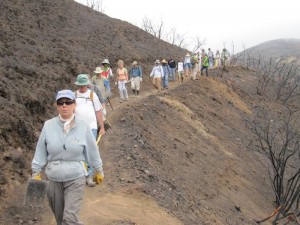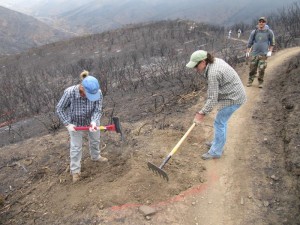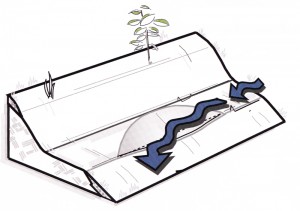 This past Saturday, 22 CORBA volunteers, along with others from the Santa Monica Mountains Trails Council, Calabasas Day Hikers, a local boy scout troop and Coyote trail runners, hiked up the Wood Canyon Vista Trail, part of the Backbone Trail system, in Point Mugu State Park, to repair the trail after the Springs Fire a few weeks ago, and prepare it for the fall and winter rains.
This past Saturday, 22 CORBA volunteers, along with others from the Santa Monica Mountains Trails Council, Calabasas Day Hikers, a local boy scout troop and Coyote trail runners, hiked up the Wood Canyon Vista Trail, part of the Backbone Trail system, in Point Mugu State Park, to repair the trail after the Springs Fire a few weeks ago, and prepare it for the fall and winter rains.
The trail had already been cleared of fallen chaparral, so the goal on Saturday was to build new drains and fix existing ones to get the water off it as quickly as possible. With many hillsides completely devoid of vegetation, any heavy rain will wash ash, dirt and other debris down onto the trail, turning some sections into piles of silt, and others into huge ruts. To prevent that, we built or rebuilt 84 drainage “nicks” along the 1.8 mile trail.
Though normal use, a trail becomes “cupped;” the edges are higher than the middle; the higher outside edge is called the “berm.” Water that flows onto a cupped trail, whether it falls on it directly as rain, or runs down from the hillside above, will run straight down the trail like a bobsled chute, carving a deeper and deeper rut as it gains speed and volume on its way to the bottom.
A nick is a shallow, oblong depression on the trail, offset so the deepest part is at the downslope edge of the trail and cuts through the berm that would otherwise block the water from running off. The nick should extend into the trail just far enough to include the deepest part (the section that is most cupped or rutted). Water running down a trail will run out the nick rather than continuing down the trail.When constructed properly, the nick should not be noticed by most trail users, and will be gentle enough that mountain bikers might notice a small bump, if anything at all. It should definitely not be a hazard that could buck a biker off the seat.
I prefer to build nicks with a small “ramp” just downhill of them. A ramp is a very shallow mound of dirt that raises the height of the trail an inch or two just below the nick, helping to keep water from running down the trail by diverting it out the nick. A nick with a downhill ramp doesn’t have to be dug as deep as one without. Unfortunately the dirt was so dry, a ramp would be just a pile of dust that would be scattered to nether regions as trail users passed through.
 Overall, we built 84 nicks. About 2/3 of them were new; the rest were old ones that were cleaned out or rebuilt. Of those, some already had downhill ramps; I think they will turn out to be the most effective and resilient.
Overall, we built 84 nicks. About 2/3 of them were new; the rest were old ones that were cleaned out or rebuilt. Of those, some already had downhill ramps; I think they will turn out to be the most effective and resilient.
You can see photos of the volunteers and the work they accomplished in our June 8th Trailwork Photo Gallery.
After the work was finished, we had the customary mountain bike prize giveaway followed by a lunch provided by CORBA to show our appreciation for our volunteers.
Thanks to everyone who came out to help keep our trails in great shape and survive the winter rains!





[…] kinds of features on the trail. Most noticeable was the lack of serviceable drainage dips. Of the 84 drains we installed after the Springs Fire in 2013, almost all were choked with debris, and many couldn’t even be distinguished from the […]
[…] kinds of features on the trail. Most noticeable was the lack of serviceable drainage dips. Of the 84 drains we installed after the Springs Fire in 2013, almost all were choked with debris, and many couldn’t even be distinguished from the […]